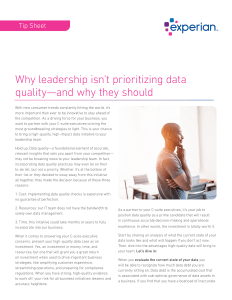With new consumer trends constantly hitting the world, it’s more important than ever to be innovative to stay ahead of the competition. As a driving force for your business, you want to partner with your C-suite executives to bring the most groundbreaking strategies to light. This is your chance to bring a high-quality, high-impact data initiative to your leadership team.
Hold up. Data quality—a foundational element of accurate, relevant insights that sets you apart from your competition— may not be breaking news to your leadership team. In fact, incorporating data quality practices may even be on their to-do list, but not a priority. Whether it’s at the bottom of their list or they decided to sway away from this initiative all together, they made the decision because of these three reasons:
1. Cost: implementing data quality checks is expensive with no guarantee of perfection.
2. Resources: our IT team does not have the bandwidth to solely own data management.
3. Time: this initiative could take months or years to fully incorporate into our business.
When it comes to answering your C-suite executive concerns, present your high-quality data case as an investment. Yes, an investment in money, time, and resources, but one that will grant you a great return on investment when used to drive important business strategies, like amplifying customer experience, streamlining operations, and preparing for compliance regulations. When you have strong, high-quality evidence to work off, your risk for all business initiatives lessens and accuracy heightens.
As a partner to your C-suite executives, it’s your job to position data quality as a prime candidate that will result in continuous accurate decision-making and operational excellence. In other words, the investment is totally worth it.
Start by sharing an analysis of what the current state of your data looks like and what will happen if you don’t act now. Then, dive into the advantages high-quality data will bring to your team. Let’s dive in:
When you evaluate the current state of your data you will be able to recognize how much data debt you are currently sitting on. Data debt is the accumulated cost that is associated with sub-optimal governance of data assets in a business. If you find that you have a boatload of inaccurate data and unnecessary costs associated with capturing and managing those records, don’t fret. Our research shows, 78 percent of organizations say data debt is a problem for them. These statistics will support your data quality initiative and answer any cost-related concerns coming from your leadership team.
If you don’t incorporate data quality practices now, the inevitable will happen—your pile of data debt will grow, costs will continue to increase with little to no return on investment, invalid data will continue to drive business decisions, and market opportunities will be missed. As Steve Philpotts, general manager of data quality and targeting for Experian Australia says, “Poor data is often entangling entire organizations with crippling effects, preventing timely decision-making and negatively impacting customer experience.” To make matters more grueling, your bottom-line will be negatively impacted. If you don’t take steps to incorporate data quality practices into your business now, you will be creating more (re)work for yourselves in the future.
The data quality advantages outweigh the concerns — really. When you evaluate and transform your invalid data to one comprehensive view of trustworthy insights, you will begin to make precise decisions and awarded key market opportunities. Some key advantages to high-quality data are:
• Improved customer experience
• Streamlined operations
• Risk management
• Data debt relief
• And more!
When you reap the benefits of high-quality data, you can use correct data to drive initiatives like personalized marketing campaigns, revamping your operation efforts, and preparing for compliance regulation, which all will influence a competitive edge and bottom-line growth for your business.
When your business is making decisions off of dependable evidence, you can be confident you are responding to consumer trends in a way that makes sense for your business and customers. You will be the frontrunner in your industry and in the eyes of your customers—all because you are supported by high-quality, validated insights.



